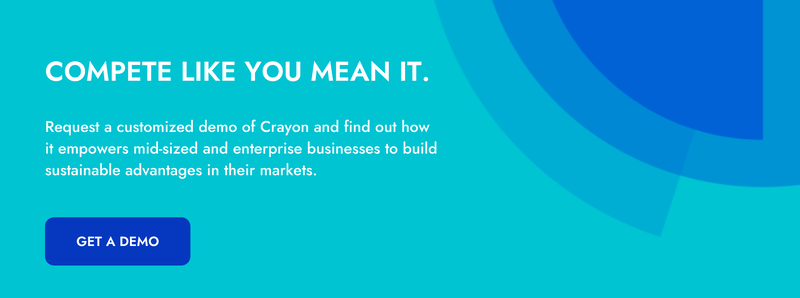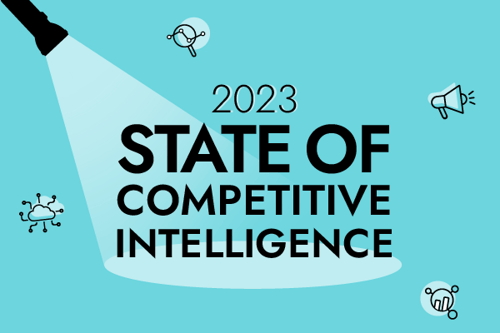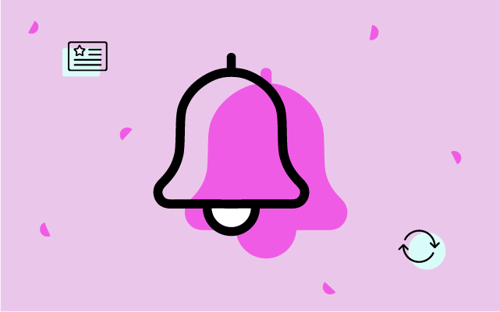I don’t think I’ve ever walked up a basement staircase. If I’m feeling courageous, my ascension might look something like a casual jog. Most of the time, though, I’m climbing that thing as fast as I possibly can.
Not because of the darkness itself, of course—but rather because of what lurks in the darkness.
Some may sneer, but in the eyes of anyone who’s tried to do competitive intelligence without the help of automated tracking, my behavior is all too rational. When it’s on you, a human being, to manually keep tabs on the competition, you’ll inevitably find yourself in the dark, prone to getting blind-sided at any given moment by a major product release or campaign launch.
So you buy a CI software solution. Hooray! You’re no longer in the dark. Problem solved.
Kinda.
If you’re not careful, you may find yourself in a different—yet equally scary—situation.
Out of the dark, into the noise
Some CI software solutions take a non-tiered approach to competitor tracking, meaning you get the same breadth and depth of data for each entity in your competitive landscape.
Underlying this approach is a philosophy that I wholeheartedly endorse: In order to proactively detect threats and mitigate risk, you need to keep tabs not only on the companies that you directly compete with, but also entities such as:
- Indirect competitors
- Thought leaders
- Partners
- Regulators
- Suppliers
- Key clients
But the non-tiered approach has a fundamental flaw: “Keeping tabs” on a fierce rival that shows up in every single one of your sales opportunities is not the same as “keeping tabs” on a company that operates in an adjacent market.
On the former, you need deep intelligence: release notes, new website pages, trend anomaly detection—anything that can help you:
- Understand their strengths, weaknesses, and priorities, and
- Empower stakeholders across your organization to make decisions and execute accordingly.
On the latter, you need high-level intelligence: news mentions, press releases, tweets—just enough to ensure that you’re aware of potentially disruptive developments, but not so much that you’re distracted by companies that don’t impact your business and drowning in meaningless noise.
A non-tiered approach to competitor tracking comes with a whole lot of meaningless noise.
The most obvious downside to being inundated with noise is that you’re destined to lose your marbles. You can only consume so much information about your kinda-sorta competitor before you go off the deep end.
But there’s also a less obvious, more insidious downside: The time you spend sifting through noise and searching for stuff that matters is time you don’t spend analyzing the stuff that matters and translating your analysis into actionable insight.
Expected to keep your colleagues informed but unable to identify the so what, your only option is to dump links—without much context—into emails, Slack channels, battlecards, and the like. You’re doing your best, but your stakeholders aren’t getting much value, and as a result, the perception of your CI program quickly turns negative.
It’s not your job to boil the ocean, but sadly, this is the reality for far too many CI practitioners—through no fault of their own. They’re led to believe that non-tiered competitor tracking will get them more bang for their buck, only to find themselves with a new problem on their hands.
It doesn’t have to be this way.
Out of the dark, into the light—with Crayon
As a Crayon customer, you take a tiered approach to competitor tracking: You get deep intel on the companies you directly compete with and high-level intel on everyone else.
You get, in other words, everything you need and nothing you don’t—and as a result, you have ample time to identify the so what, transform intel into insight, and drive better decision-making and execution across your organization. Perception of your program is positive from the get-go, and a culture of competitive intelligence takes shape organically.
You may be thinking: That sounds nice and all, Conor, but you’re breezing past an important detail: In order to take this approach, I have to decide who is and isn’t worthy of top-tier tracking. That’s not as straightforward as it sounds.
True—it’s not straightforward. But I have two pieces of good news for you:
- Your data—and your stakeholders—will make the decision for you. Who comes up frequently in your opportunities? Who doesn’t? Don’t waste your time on companies that aren’t threatening your market share. And don’t forget to do thorough discovery with your stakeholders, too. Grill them with open-ended questions until it’s obvious why they’re losing sleep, who is keeping them up, and what they need from you. Frankly, if you’re not sure who is and isn’t worthy of top-tier tracking, you haven’t done enough discovery with your stakeholders.
- Nothing is set in stone. The beauty of getting high-level intelligence on everyone else in your competitive landscape is that you can clearly see who’s emerging as a direct competitor. And when that happens, it’s easy to make the necessary changes to your tracking parameters. We do this all the time. You don’t need to worry about making the “wrong” decision.
Some may say that, compared to a non-tiered approach, the tiered approach to competitor tracking demands more work up front. First of all, this is misleading: Use the non-tiered approach and eventually you’ll end up expending tons of energy setting up your tracking parameters and figuring out how you’re going to prioritize and digest everything—because when everything is important, nothing is important.
Secondly, the up-front work that comes with the tiered approach is work that you have to do no matter what in order to succeed with CI over the long term.
So, you need to ask yourself a question. Would you rather:
- Do a little more work up front, delight your stakeholders from the get-go, and enjoy long-term success, or
- Do less work up front, frustrate your stakeholders from the get-go, and go back to the drawing board after a few months of poor results?
Not a hard decision, if you ask me.

Seeing is believing! Check out Crayon for yourself.
Take a Product TourRelated Blog Posts
Popular Posts
-
 The 8 Free Market Research Tools and Resources You Need to Know
The 8 Free Market Research Tools and Resources You Need to Know
-
 6 Competitive Advantage Examples From the Real World
6 Competitive Advantage Examples From the Real World
-
 How to Create a Competitive Matrix (Step-by-Step Guide With Examples + Free Templates)
How to Create a Competitive Matrix (Step-by-Step Guide With Examples + Free Templates)
-
 24 Questions to Consider for Your Next SWOT Analysis
24 Questions to Consider for Your Next SWOT Analysis
-
 How to Measure Product Launch Success: 12 KPIs You Should Be Tracking
How to Measure Product Launch Success: 12 KPIs You Should Be Tracking



